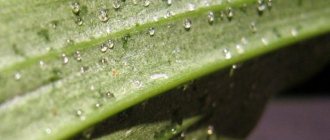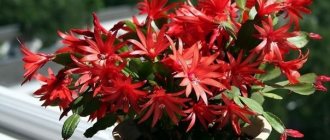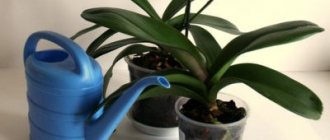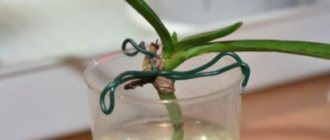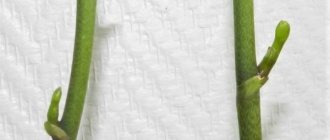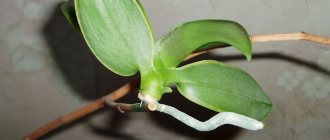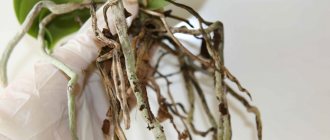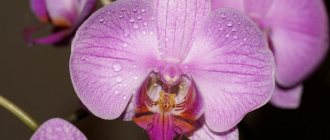Plants » Flowers
0
1598
Article rating
Kira Stoletova
Sometimes it is not possible to force a phalaenopsis orchid to produce a peduncle, despite the fact that the plant looks healthy and receives the necessary care. Orchids without a peduncle are the result of mistakes in care.
Orchids without a peduncle
What is a flower shoot?
Peduncle - a shoot (arrow) running upward from the base of the plant on which flowers are formed, or, in a narrower sense, a segment of the plant stem on which flowers are formed.
The peduncle is very similar to the root of an orchid, so often inexperienced gardeners make irreparable mistakes in caring for the plant, which can lead to the fading or death of the peduncle. What are the main differences between a peduncle and a root?
- The shape of the root is round, and the peduncle is cone-shaped.
- The flowering shoot appears only from the leaf axil.
- The arrow appears above the previous flowering site.
- The presence of irregularities on the peduncle - buds - is mandatory.
Most often, the orchid produces flower stalks in the fall, when the temperature differences between day and night are large: from +25C to +15C. The average period for the formation of a flower arrow is 2 – 3 months (from the moment of appearance to the stage of the formed peduncle). If the grower creates comfortable conditions for the plant, this process can be accelerated. At the same time, this will guarantee that the home beauty will definitely bloom.
Drying of old flower stalks: reasons
The drying out of old flower shoots that were actively flowering is, as a rule, a natural process. This is especially true for branched peduncles, in which the lateral buds (the so-called “meristematic”) have already produced their own shoots. Such arrows have almost completely exhausted their resource, and the orchid simply gets rid of them.
The situation is somewhat different with flower stalks, on which the lateral buds have not yet awakened, and flowering occurred only at the top. If such an arrow begins to become exposed, it is necessary to examine its condition:
- Inspection of the top. If it remains green and the apical bud does not dry out, the orchid simply pauses flowering and will begin to grow after a while. If the top turns yellow and dries out, the plant stops flowering along the main axis.
A living and green apical bud indicates the viability of the peduncle. Even if it drops all its flowers and stands naked for some time, this will not necessarily lead to its death and drying out.
- Inspection of the lateral kidneys. There are 3-4 buds on the arrow, covered with scales. If the scales are green, it means that the buds may wake up soon, and there is no need to touch the arrow. If the scales are parchment-like and dry, the buds are “frozen” and can dry out along with the peduncle.
After growth along the main axis stops, you can transfer it to the nearest living lateral bud by cutting off the arrow above it. But if the kidney is dormant, success is not guaranteed.
How important is flowering?
The peduncle is the most important part of the orchid. Some florists call it the “heart” of the plant. It is this that provides all the beauty of the orchid, since flowers form on it. As you know from biology lessons, a flower is a means by which a plant attracts insects for pollination, that is, for procreation. As confirmation of this, it is on the peduncles that babies appear, which can then be easily rooted and a new plant can be obtained (read about how to grow a baby on an orchid peduncle here).
While the orchid's peduncle is growing, the plant should under no circumstances be replanted (we talked in detail about caring for the orchid before and during flowering here)!
Why doesn't the plant shoot out shoots?
Important. The reasons why problems with the peduncle arise depend on what type of orchid we are talking about. Without knowing the specifics of caring for a particular orchid variety, you cannot hope for its systematic, abundant flowering!
All orchids are divided into sympoidal and monopoidal. The latter have only one growth point, the bush does not divide, it has no dormant period: vandas, phalaenopsis, ascocendes. Sympoidal ones need a period of rest, which should be properly ensured. In other words, what is good for phalaenopsis and dendrobium will be irrelevant for vanda, cymbidium, and cattleya.
Before expecting the peduncle to grow from an orchid, you need to familiarize yourself with specialized literature on the issue of creating the necessary conditions for maintaining a certain type of flower. And then it is necessary to analyze: why does the orchid not produce a peduncle, are the conditions created suitable for it, and if they are unsuitable, then what should be done? If the epiphyte does not have enough light, the watering schedule is not adjusted, the correct temperature regime is not maintained, or the plant has been fed for a long time, then flowering is out of the question.
Some florists resort to special preparations, for example, cytokinin paste. It is a phytoharmone, its main purpose is to awaken dormant buds, form shoots in the intended place, and accelerate the flowering of the plant. Another drug is succinic acid (4 tablets per 1 liter of water). Place a pot of orchid in a solution of acid and water overnight. In order for an orchid to send out a flower stalk, doing this once is not enough - a similar procedure should be carried out at least once a week.
What if there is no escape or it is frozen?
In order to find out why the arrow is not growing, you first need to make sure that the plant is healthy. Perhaps the reason lies in some kind of disease. And, of course, it is worth analyzing whether all conditions for caring for the orchid that has released a peduncle are provided. If not, then you must do everything possible to ensure that they are met.
In order for the released arrow to bloom, certain requirements must be met:
- Lighting. Orchid loves a lot of diffused light. The daylight hours for the arrow to emerge must be at least 12 hours, otherwise this can lead to the peduncle fading. The best place is south-east or south-west windows.
- Temperature. Orchid is a tropical plant that loves warmth. It feels comfortable at +25C, but the night temperature should be an order of magnitude lower: the difference between day and night temperatures should be about 5C.
- Watering. The general rule for watering all orchids remains in force: as the soil dries.
- Humidity. We should not forget about systematically spraying the plant with warm, settled water, while not forgetting about watering. However, direct impact on the plant can also be destructive, so experienced gardeners advise “enveloping” the orchid with water dust: placing the epiphyte in the center of a group of other plants and spraying them.
- Feeding. Important elements for the flower during the shoot season are phosphorus and potassium. It is better to fertilize the plant with special fertilizers for orchids, purchased in a store (for example, Agricola), 1 - 2 times a month until the period of active flowering.
Conditions for the formation of a peduncle
To eliminate the reason why an orchid does not grow a peduncle for a long time, it is necessary to identify and eliminate the root of the problem.
Air humidity
So, how to revive an orchid without a peduncle? The first thing to do is pay attention to the humidity of the environment. The flowering arrow with opening buds is sensitive to air flows from an air conditioner or radiator . This is especially true in winter in apartments with central heating.
The plant feels good at air humidity of at least 50% . To achieve these indicators:
- the orchid is regularly sprayed;
- the pot is placed on a stand made of wet pebbles or sand;
- use humidifiers.
Too dry air causes the flower stalk to wilt and the buds to dry out.
Lighting
Light is one of the main conditions for the normal development and flowering of an orchid. Incorrect lighting will certainly affect the appearance of the plant in the form of:
- pulling leaves;
- growth slowdown;
- weak, elongated peduncle.
Lack of flowering can even cause the pot to move or the flower to turn relative to the light.
Light mode
The plant is provided with a place with intense diffused light:
- it is better to place the flower on the lightest window sill ; in the autumn season it can be a south window;
- The duration of daylight should reach 12 hours . For illumination in winter, a phytolamp with a power of 60 W is used, which is placed no closer than 20 cm from the flower.
To create an optimal light regime, phytolamps are used.
Important! Short daylight hours are the main factor for the lack of flowering in the autumn-winter period.
Properly selected lighting is the main factor in the development of the peduncle and flowering of the orchid.
Watering
A common mistake novice gardeners make is watering too often. Under such conditions, the orchid has no physiological need to flower:
- in nature, the rainy season means the beginning of the growth of vegetative parts - roots and leaf mass;
- with excess moisture, the absence of a peduncle may be a consequence of rotting of the root system.
To bring the conditions closer to natural conditions, it is necessary to give enough time for the substrate to dry. When watering an orchid, it is important to focus on the soil moisture in the pot, and not on the period of time between waterings, and you should consider:
- surface watering from a watering can poorly moisturizes the substrate, since water quickly goes through the drainage layer into the pan;
- It is considered optimal to immerse the pot up to the very edge in a tank of water for 15-20 minutes;
- For irrigation, use “soft” water containing a small amount of salts.
Watering is carried out only after the top layers of the soil have dried , as a rule, two to three times a week in the summer and every 10 days in the winter.
Top dressing
Conventional phosphorus-potassium fertilizers are not suitable for feeding orchids because they contain too high a concentration of nutrients.
For these plants, they sell fertilizers designed specifically for orchids , with a reduced nitrogen concentration:
- before applying fertilizers, water the plant with water so as not to cause root burns;
- in the winter months, as well as in the hot summer, when the temperature rises above 25℃, fertilizers are applied once, in spring and autumn - twice a month.
An orchid at the stage of leaf and root growth needs nitrogen nutrition, and during the formation of a peduncle - phosphorus and potassium. If fertilizing was carried out before the formation of the peduncle, then this can be done further until the first flower appears.
Air temperature
The bulk of flower stalks are formed in early autumn , when there is a significant difference in night and day temperatures:
- the optimal daily temperature fluctuation is within 5-7℃ and promotes the formation of flowering shoots;
- In summer, the most comfortable daytime temperatures for a flower are from 15 to 30℃, in winter – 20-23℃.
To stimulate the forcing of the peduncle, the plant can be taken out of the apartment to the balcony at night.
To stimulate flowering, orchids can be placed on a cool balcony.
What to do if there are no buds?
Many orchid lovers complain that their beauties “sit” in place, not pleasing with their blooms for several years. What needs to be done in such a situation for the plant to shoot? To begin with, just try to move the flower to a new place. If it doesn’t help, then there are several options for “shock therapy”, which are strongly recommended by experienced florists.
Temperature changes
- Move the flower with the pot to a place where there is a temperature difference of 5C - 7C: it should be cool at night, warm during the day. The best place is a balcony, veranda.
- It is imperative to check for drafts, as the plant does not tolerate them and may die.
Shading and reducing humidity
- Move the container with the epiphyte to a darker place than the one to which it is accustomed.
- Reduce as much as possible and sometimes completely stop watering the plant, giving it a kind of “drought.”
- After 1.5 -2.5 weeks, carry out the first moderate watering.
Reducing the frequency of watering
Reduce watering the orchid by half: for example, if watering was carried out once every 5 days, then you need to start watering the plant once every 10 days.
- Between dry intervals, moderate watering with boiled water at room temperature is recommended.
- You cannot spray the plant at this time or moisten the substrate with a spray bottle.
It is unacceptable to use several techniques at the same time, as this can lead to the death of the flower!
Rules of care
After the arrow appears in the orchid, two important rules are followed.
- The shoot with buds should not be touched at any stage of development.
- During the formation of the peduncle and the blooming of flowers, you cannot replant the crop.
On a note!
Sometimes a new leaf begins to grow, and the flower shoots an arrow. In this case, the choice is left to the flower itself. The culture itself will determine what is more important for its development - flowering or the formation of new leaves.
Until the moment when the shoot hatches, you need to care for the orchid traditionally, but after the arrow forms, you should slightly change the principles of cultivation.
Reducing the watering schedule
During the period of peduncle growth, the watering regime is changed. It is being gradually reduced. The soil should not be allowed to dry out.
Previously, from watering to watering there was 2-3 days of drying, this period can be done about 5 days. Usually, if orchids are watered weekly before the peduncle appears, then after it appears, watering is carried out once every 2 weeks.
Features of fertilizing
Frequent application of fertilizing affects the duration of flowering - the period is shortened with abundant application of nutrients.
Therefore, during the formation of flowers, the application of fertilizers is gradually reduced. And when the first flower appears, you should stop feeding altogether.
Lighting and temperature
Depending on the period when the flower arrow appeared, choose the location for the pot:
- if the peduncle grows on an orchid in autumn or winter, the flower is transferred to a young windowsill;
- In spring, the flower is removed from the southern window and diffused light is provided.
On a note!
If there are no windows on the south side, then additional lighting is provided in winter and autumn.
For proper development of the released arrow, the temperature in the room should be between 23-26 degrees. If the room is too cold, development will stop, and if it is too hot, it may dry out.
Getting multiple stems at home
The number of flower stalks on an orchid directly depends on the genetic characteristics of the species that was acquired. An important role is played by such factors as the age of the plant, the power of its root system, the quantity and quality of lighting, regularity of watering, and compliance with the optimal temperature regime.
Provided that all requirements for the care and maintenance of the orchid are met, you can try to increase the number of flower stalks as follows:
- After flowering, cut off old flower stalks (making sure they are completely dry).
- Treat leaves and substrate with fungicide.
- Feed the plant with specialized fertilizers for orchids.
After the orchid peduncle dries to the very base, it should be trimmed. To do this you will need sharp scissors or pruning shears and activated carbon. Using a sharp, clean tool, cut off the dried peduncle, not reaching two centimeters to the surface of the substrate. The cut area is treated with crushed activated carbon.
Some florists advise: not cut off the peduncle completely, but to the very top “dormant” bud, since a lateral arrow may begin to develop from it, and a second shoot may appear from the axil of the leaves. In this way it will be possible to obtain a plant with two peduncles.
Rules for pruning drying flower stalks
Arrows that have begun to dry out need pruning. There are two main strategies practiced among gardeners: full pruning and partial pruning. The choice depends on what result you want to achieve:
| Pruning strategy | In what cases is it chosen | Technique | Expected Result |
| Full | If the peduncle is unpromising or interferes with the development of young shoots | Option 1: another green arrow is cut onto the stump, along living tissue, not reaching 2-3 cm to the base. Option 2: the arrow is left until completely dry, after which it is cut into a stump using dry cloth. | The orchid sends out new arrows from the stem. |
| Partial | If the peduncle has promising side buds and dries only at the top | The arrow is cut 2 cm above a promising living bud | The orchid transfers growth to a side bud and produces a new peduncle or baby from it. |
It should be noted that partial pruning does not always give a positive result. Sometimes gardeners observe further drying of the arrow:
“Partial pruning didn’t do any good for me. “I amputated” the peduncle in pieces. At first I cut it off above the very top side bud, but it continued to dry out. Then I cut it above the lower side. The drying stopped for a while. I waited for almost two months for my kidney to wake up. And yesterday I noticed that the needle was already turning completely yellow. I cut it out completely. I just lost time, it turns out” (Marina, Yaroslavl).
Indeed, sometimes partial pruning only slows down the death of the arrow. On the other hand, many gardeners manage to achieve resumption of flowering. Moreover, often after cutting the top, not just one, but all the lateral buds awaken at once. However, to do this, after drying the cut, you need to feed the orchid and give it good light and the right temperature.
It is impossible to predict exactly how a bud will behave: it will produce a baby, begin to grow an inflorescence, or dry out. It all depends on the conditions and individual characteristics of the orchid.
How to direct the arrows to grow upward?
Wait until the arrow reaches a length of 15 - 20 cm. While it is green, it is very flexible and can easily change the direction of its growth.
- The grown shoot must be fixed in a vertical position using a support in the pot and a special clothespin (elastic band, hairpin, etc.).
- If there is a risk of injury to the peduncle or even breaking it, then fixation can be carried out gradually. In order to bring the peduncle as close as possible to the support, it is tied with an elastic band, rope, tape or bandage to the holder, gradually reducing the distance between them over time.
We suggest watching a video on how to properly secure a peduncle so that it begins to grow upward:
Preventing problems
It should be noted that in their natural environment - the tropics - orchids grow on trees from which their flower stalks hang under the weight of buds and flowers. Therefore, the growth of shoots not vertically upward, but horizontally is a natural process for this plant, inherent in nature. The only way to prevent such a situation at home is to constantly turn the orchid pot as the peduncle deviates to the side. It will reach towards the light, thereby aligning itself.
As for the problems of “freezing” of the growth of the peduncle or the reluctance of the orchid to bloom at all, there is only one recommendation: strictly adhere to the requirements for the maintenance and care of a certain type of orchid.
Caring for an orchid is a labor-intensive process. Difficulties can arise at every step. Only perseverance, determination, and attentiveness of the gardener will help him achieve the main goal when growing an orchid - admiring the beauty of the flower for a long time.


